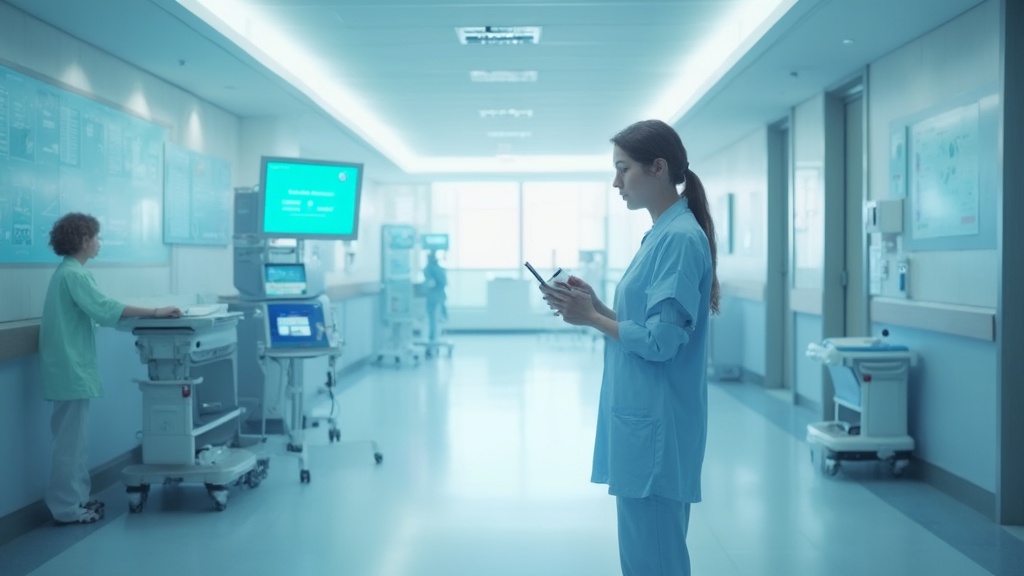Introduction
In an era where healthcare demands are rapidly evolving, automation emerges as a pivotal solution to enhance efficiency and improve patient outcomes. Automation in healthcare not only streamlines administrative tasks but also ensures that healthcare professionals can dedicate more time to direct patient care. This shift not only reduces operational costs but also significantly enhances the quality of care provided.
By integrating advanced technologies like AI and machine learning, healthcare facilities can revolutionize their operations, leading to faster, more accurate processes and substantial cost savings. This article delves into the multifaceted benefits of healthcare automation, explores real-world examples of its implementation, and addresses the challenges and best practices for integrating these technologies into healthcare systems. Discover how embracing automation can transform healthcare delivery, making it more efficient, effective, and patient-centric.
Benefits of Automation in Healthcare
Automation in medical services provides groundbreaking advantages, such as enhanced operational efficiency, decreased administrative loads, and better outcomes for individuals. By automating routine tasks, medical providers can allocate more time to patient care, ensuring that staff focus on higher-value activities that enhance service delivery. For instance, automated systems can handle prior authorizations, billing, and insurance claims, expediting processes and reducing the need for manual interventions, as evidenced by a significant decrease in physician abandonment rates from 31% to 25%.
The effect of mechanization extends to substantial cost savings. By eliminating more than 6,800 hours of manual audit work annually, healthcare organizations like The University of Kansas Health System have demonstrated the financial benefits of automation. These savings allow for reinvestment in healthcare services and advanced technologies, promoting an environment where resources are utilized more effectively.
Automation also leads to enhanced outcomes for individuals receiving care. By streamlining processes and reducing errors, individuals receive timely and accurate care. For instance, referral intake times can be significantly decreased, enabling individuals to be scheduled in minutes instead of days, thus improving satisfaction and health outcomes.
The incorporation of AI and machine learning technologies in medical care further emphasizes the potential of mechanization to transform the industry. New tools, like those recently announced by Microsoft, aim to save clinicians’ time on administrative tasks, which can constitute up to 41% of a nurse’s workload. This decrease in administrative tasks not only eases exhaustion but also enables medical professionals to devote more time to direct client support.
In summary, medical institutions that adopt automation and AI technologies will be more prepared to address the changing requirements of individuals, providing high-quality care efficiently and effectively.
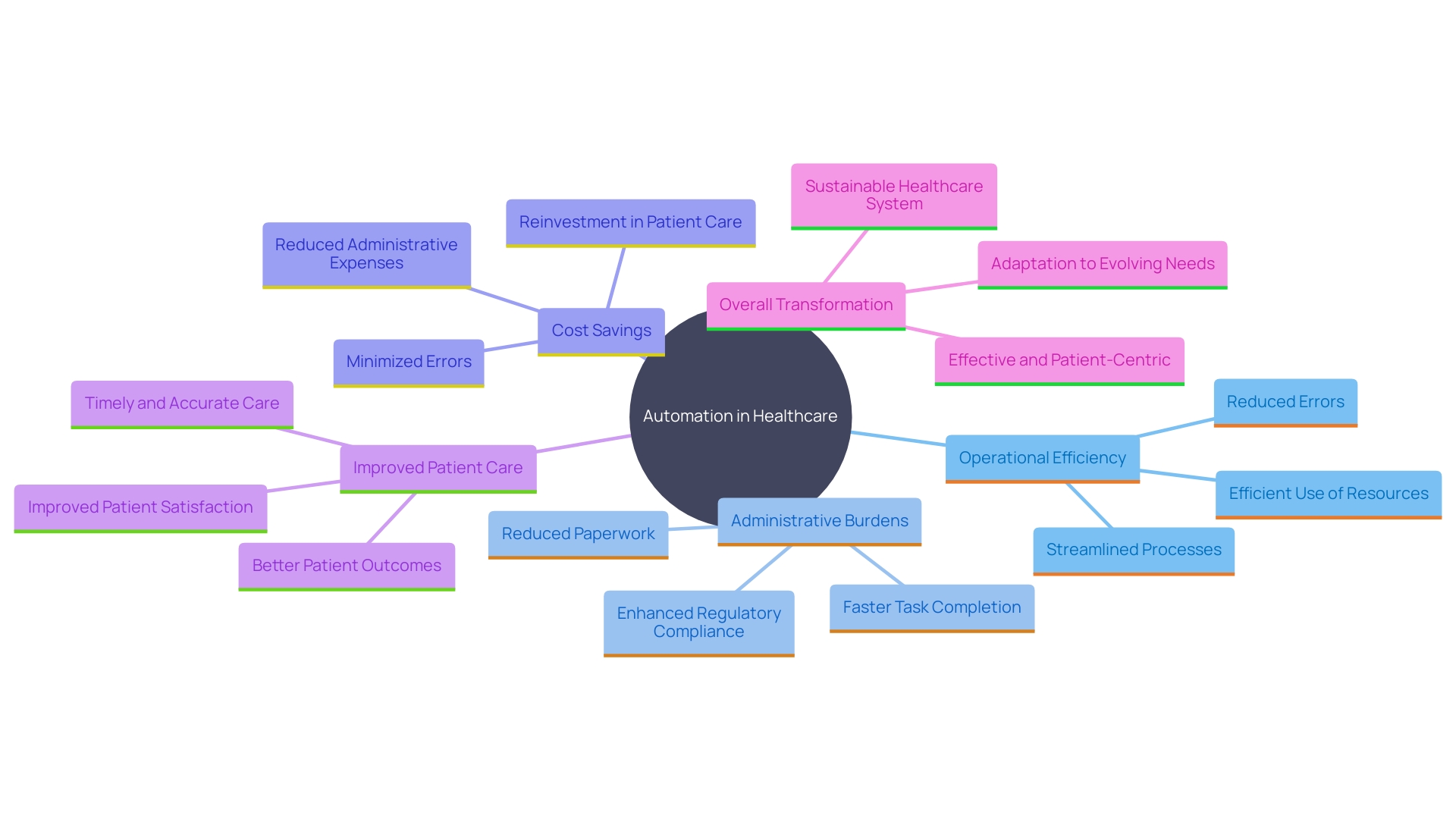
Streamlining Administrative Tasks
Administrative tasks often consume a significant portion of medical professionals’ time. Automation solutions can streamline processes such as appointment scheduling, client registration, and billing, reducing the time and effort required for these activities. By implementing automated workflows, healthcare organizations can minimize errors, enhance data accuracy, and improve client satisfaction through quicker and more efficient service.
For instance, the University of Kansas Health System has successfully implemented automated registration audits for over 38,000 visitor encounters. This innovation has enabled them to audit the performance of over 1,000 registration representatives without incurring additional costs. This automation has guaranteed individuals’ access to essential treatment, precise coding, and enhanced financial results, showcasing the concrete advantages of automation in medical services.
A recent analysis from Google Cloud and The Harris Poll emphasized that medical professionals dedicate almost 28 to 36 hours each week to administrative duties, resulting in burnout and decreased time for those they serve. Automation can ease this burden, enabling staff to concentrate more on patient support, thus enhancing patient outcomes and satisfaction. By minimizing mistakes and optimizing processes, healthcare providers can offer prompt and precise services, significantly improving health outcomes.
Furthermore, automation can lead to substantial cost savings by reducing administrative expenses and minimizing errors. These savings can be reinvested in healthcare and other vital services. As an example, automating the referral intake process ensures individuals are scheduled in minutes rather than days, leading to more efficient and effective treatment.
In summary, adopting automation in healthcare not only alleviates the administrative load but also improves the overall effectiveness, precision, and quality of services provided to individuals.
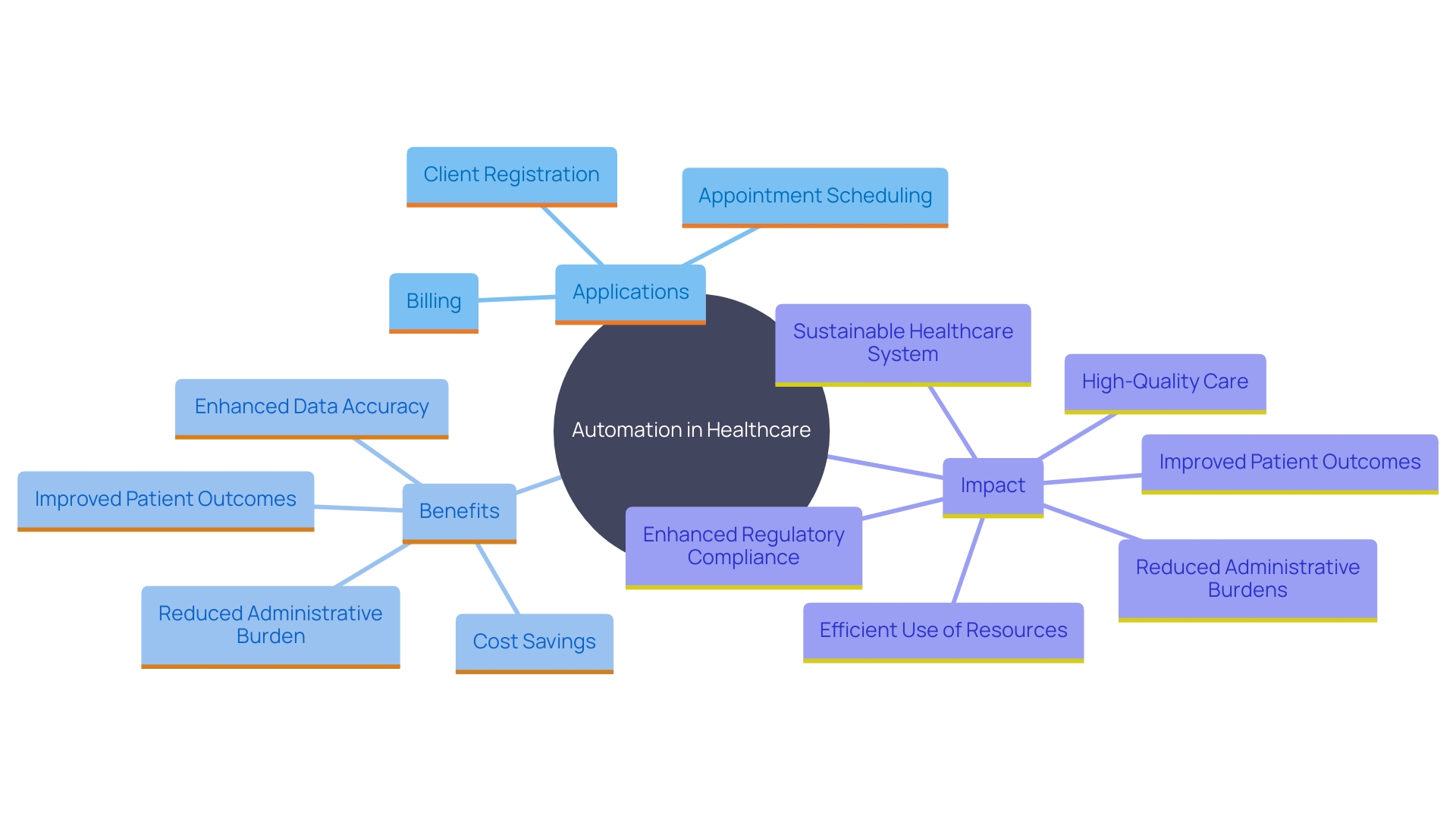
Enhancing Patient Care with Automation
Automated systems transform healthcare by ensuring timely access to critical information, facilitating personalized treatment plans, and enhancing communication between providers and individuals. Telemedicine platforms and automated reminders for medication adherence are instrumental in empowering individuals to actively manage their health, leading to improved outcomes and higher engagement.
Recent advancements in AI, such as Summer Health’s use of GPT-4 to generate visit notes, have significantly reduced administrative burdens for healthcare providers, allowing them to dedicate more time to care for individuals. This innovation has resulted in a fivefold reduction in the time required for note-taking and administrative tasks, allowing for more valuable time for direct interactions with individuals.
Furthermore, entities such as Montefiore Einstein Comprehensive Cancer Center have effectively utilized AI tools to double the colonoscopy completion rates among individuals who canceled or missed appointments. ‘This not only enhances patient outcomes but also optimizes the efficiency of medical services.’.
Studies indicate that telemedicine is comparable in quality to in-person visits, suggesting that its increased implementation can positively impact health outcomes. For instance, the readmission rates for telemedicine and conventional office visits are almost the same, highlighting telemedicine’s effectiveness in delivering continuous, quality service.
As John Squeo from CitiusTech emphasizes, the future of medical services lies in simplifying care journeys through telehealth and automation, ensuring a more streamlined, accessible, and patient-centric system. By concentrating on minimizing administrative duties and improving patient involvement, medical systems can attain improved clinical results and patient contentment.
These technological advancements underscore the critical role of automated systems and telehealth in transforming medical delivery, making it more efficient, effective, and patient-focused.
Challenges and Considerations in Healthcare Automation
While the benefits of automation in medical services are substantial, several challenges must be addressed to ensure successful implementation. Resistance to change, data privacy concerns, and integration issues with existing systems are significant hurdles. For instance, the integration of AI and digital wellness solutions like those offered by Infermedica into existing medical systems can be complex and requires careful planning. Healthcare executives must engage in long-term strategic planning that is both visionary and adaptable, considering the increasing role of big data in decision-making and the necessity for robust cybersecurity measures.
Training and support for staff are crucial to overcoming resistance to change. As noted in McKinsey’s research, 75% of health system executives place a high priority on digital and analytics transformation but lack sufficient resources or planning. Ensuring staff are comfortable with new technologies requires comprehensive training programs and continuous support.
Maintaining compliance with medical regulations is another critical aspect. The Digital Technology Assessment Checklist (DTAC) is one tool used to ensure that technology meets required standards, emphasizing the need for clear guidelines on understanding medical device status. This thorough approach reduces the risk of non-compliance and enhances the overall integration process.
Considering these points, it is clear that while mechanization offers immense potential for enhancing operational efficiency and patient care, the route to implementation must be approached with careful consideration of these challenges.
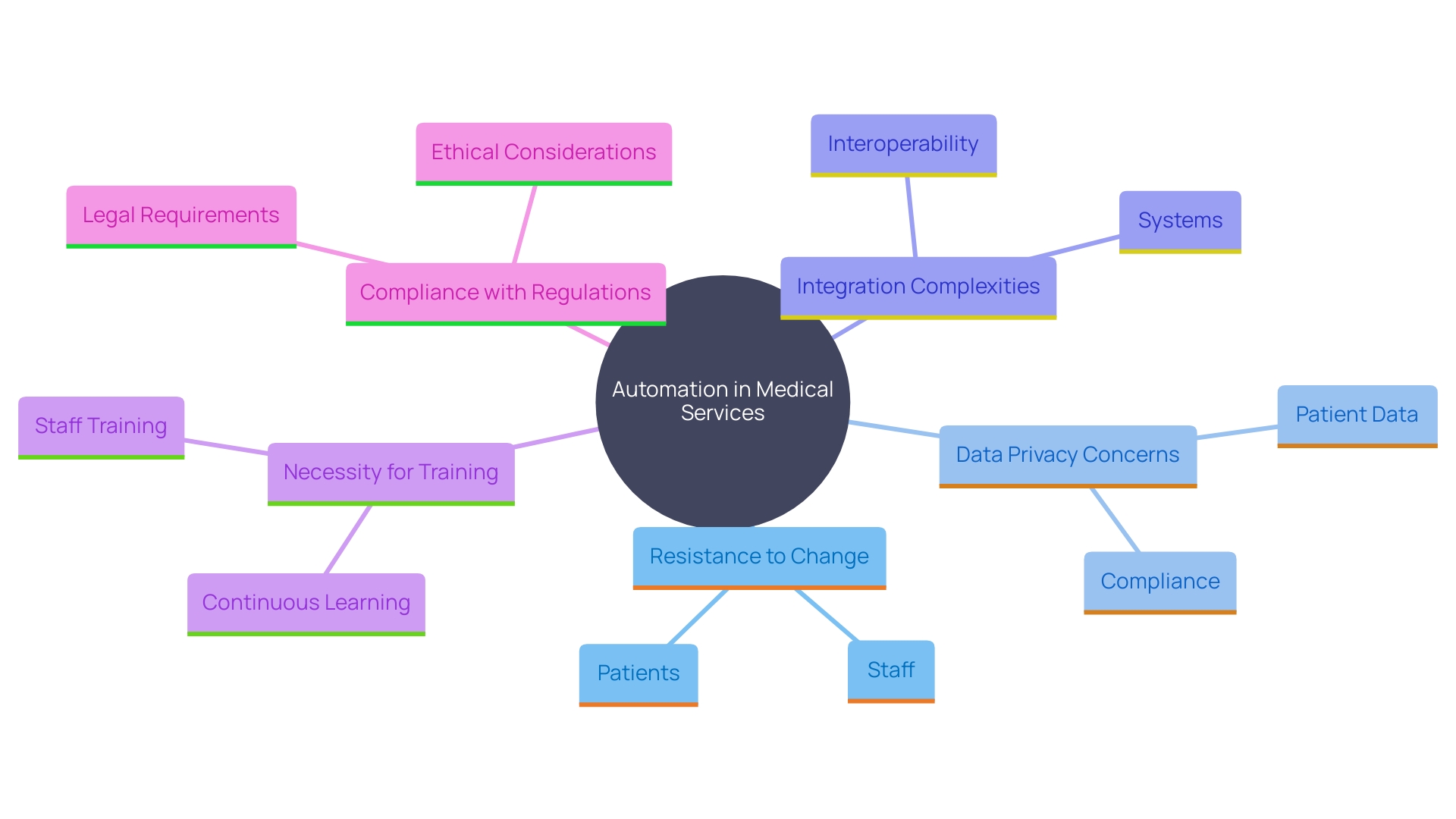
Best Practices for Implementing Healthcare Automation
To successfully implement healthcare technology, organizations should start with a clear strategy that aligns with their specific goals and operational needs. This approach is exemplified by the Mass General Brigham hospital system, which faced a bottleneck in tracking providers. They formed a team dedicated to streamlining processes that included developers and a process specialist from the finance department. This team built and managed automation tools, restructuring workflows to enhance efficiency. The new tool automatically collected and organized provider data, enabling the finance team to focus on higher-value tasks.
Engaging frontline staff in the planning process fosters buy-in and ensures that solutions are user-friendly. For instance, collaboration between departments is crucial, as highlighted by Ms. Fox, who emphasized understanding each team’s challenges and leveraging them for improvement. Continuous monitoring and feedback loops are essential for refining automated processes over time. This holistic approach not only enhances operational efficiency but also improves outcomes for individuals. By optimizing procedures and minimizing mistakes, healthcare organizations can guarantee prompt and precise treatment, resulting in improved satisfaction and health outcomes. Furthermore, automation can lead to significant cost savings by reducing administrative expenses and minimizing errors, allowing these savings to be reinvested in patient care and other essential services.
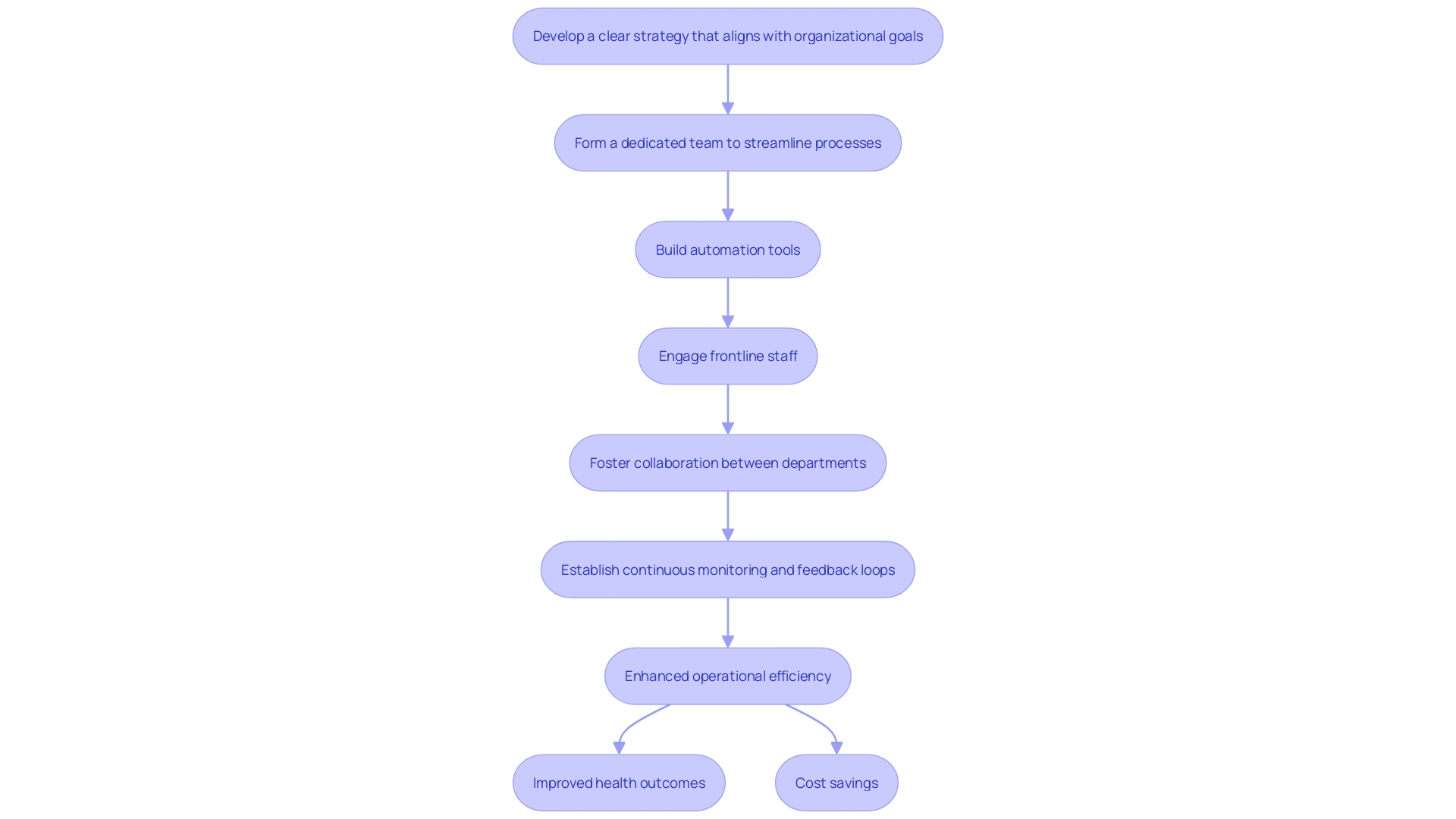
Conclusion
The integration of automation in healthcare presents a multitude of benefits that can significantly transform how care is delivered. By streamlining administrative tasks, organizations can enhance operational efficiency, reduce costs, and ultimately improve patient outcomes. The use of automated systems for tasks such as billing, appointment scheduling, and patient registration not only alleviates the administrative burden on healthcare professionals but also allows them to focus on what truly matters—providing quality patient care.
Moreover, the advent of AI and machine learning technologies has further amplified the potential of automation in healthcare. These innovations facilitate timely access to critical information, improve communication between providers and patients, and empower individuals to manage their health actively. The success stories from various healthcare organizations illustrate how automation can lead to higher patient engagement, satisfaction, and health outcomes.
However, the journey toward successful automation is not without its challenges. Resistance to change, data privacy concerns, and the complexities of integrating new systems into existing workflows must be addressed comprehensively. Organizations must prioritize training and support for staff, ensuring they are equipped to navigate these changes effectively.
By embracing best practices in planning and implementation, healthcare systems can unlock the full potential of automation, paving the way for a more efficient, effective, and patient-centric future in healthcare delivery.

